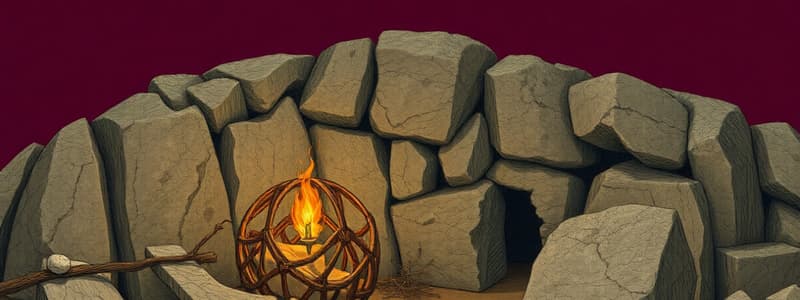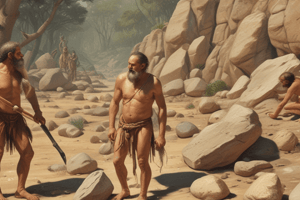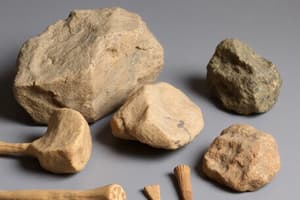Podcast
Questions and Answers
How did the development of mud plaster and pottery contribute to the advancement of early human settlements?
How did the development of mud plaster and pottery contribute to the advancement of early human settlements?
Mud plaster led to pottery and mud brick houses, improving shelter and storage.
Describe one way that the study of the Stone Age is divided. What is the basis of this division?
Describe one way that the study of the Stone Age is divided. What is the basis of this division?
The Stone Age is divided into the Paleolithic, Mesolithic, and Neolithic periods. This division is based on the sophistication of tools.
Explain how the discovery and use of flint and chart changed the way early humans survived.
Explain how the discovery and use of flint and chart changed the way early humans survived.
Flint and chart were shaped into cutting tools, flakes, blades, and weapons. This allowed for more effective hunting and defense.
How did early humans demonstrate scientific thinking through their interactions with the natural environment?
How did early humans demonstrate scientific thinking through their interactions with the natural environment?
What differentiates flake-tool traditions from blade-tool traditions in Paleolithic tool manufacturing?
What differentiates flake-tool traditions from blade-tool traditions in Paleolithic tool manufacturing?
Flashcards
Early Science
Early Science
Observing, recording, and analyzing environmental patterns.
Ancient Innovations
Ancient Innovations
Tools and methods discovered due to scientific advancements and archaeological excavations.
Origins of Science & Technology
Origins of Science & Technology
Science and tech developed from the search for food, survival, practicality and curiosity.
Man's Achievement in Science
Man's Achievement in Science
Signup and view all the flashcards
Stone Age Periods
Stone Age Periods
Signup and view all the flashcards
Study Notes
- Early humans were curious and attempted to understand the world.
- They analyzed, observed and recorded patterns, cycles, and repetitions in their environment.
- This led to the development and understanding of science.
- The development and progression of science allowed ancient humans to discover/invent tools and methods.
- Archeological excavation has provided data and evidence through new scientific instruments and tecniques.
- People developed science and technology while searching for food, survival, practical reasons and even curiosity.
Discovery of Mud Plaster, 10,000 BC
- Led to pottery and mud brick houses.
- The first known pottery existed in Japan around 10,000 BC.
Evidence of Science and Tech in Prehistoric Times (3000-5000 BC)
- Man's scientific achievements can be categorized as discovery and invention.
- Achievements began 3.4 million years ago during the Stone Age.
- The Stone Age is divided into 3 periods based on the degree of sophistication in the use and fashioning of tools:
- Paleolithic Period (early)
- Mesolithic Period (middle)
- Neolithic Period (new)
- The four fundamental traditions developed by Paleolithic ancestors include:
- Pebble-tool traditions
- Bi-facial tool or hand-axed traditions
- Flake-tool traditions
- Blade-tool traditions
- Stone tools consisted of flint and chart, used for cutting tools, flakes, blades, and weapons
- Flint and chart were shaped/chipped
- Flaking produces tools for cutting, chopping, scraping and sawing.
Early Stone Age
- Includes the basic stone toolkits by early humans.
- The Oldowan toolkit contains hammer stones that show battering on their surfaces.
- It is thought to be a product of Homo Habilis
- Studies indicate that the oldest Oldowan tools were by Australopithecus afarensis about 3.4 million years ago.
- The tools were simple and hard to distinguish from natural objects, producing 3 inches of cutting edges from a pound of flint.
Acheulan Toolkit
- Characteristics of this kit includes handaxes, as cutting tools.
- Also other kinds of ''large cutting tools".
- Acheulean stone tools were named after the site of St. Acheul on the Somme River in France, discovered in 1847.
- Tools were often bi-facial, producing 12 inches of edge.
Middle Paleolithic Innovation
- Innovation in stone technology began to accelerate.
- The prepared core technique was a main innovation.
- A core was carefully flaked on one side, producing a flake of predetermined size/shape in a single blow.
- Toolkits included points which could be hafted on shafts to make spears
- Also included stone awls for perforating hides/scrapers.
- Inventions included needles and thread, skin clothing, the harpoon, spear thrower and special fishing equipment.
Neolithic Period
- Marked by herding societies, adoption of agriculture, bronze smelting with a shift from food gathering to food production.
- Also marked by the development of pottery using sediments/clay.
Bronze Age (3000 BC-1200 BC)
- Bronze Age is the second principal period of the three age Stone-Bronze-Iron system.
- Generally followed the Neolithic period.
- Marked the beginning of mining and metallurgy.
- Indicates the first period in which bronze was used.
- Man began smelting copper and alloying with tin or arsenic to make bronze tools and weapons.
- A device
Iron Age (500 BC - 332 BC)
- The period in prehistory when iron was the dominant tool-making material.
- Characterized by the production of tools and weaponry using ferrous metallurgy.
- Meteoric iron has been used since 3200 BC.
Fire
- Fire was one of man's most important inventions in the Paleolithic Era.
Lesson 2: Evidences of Science and Tech During Ancient Times (3500 BC - 1200)
Sumerian Civilization (Sumer, Mesopotamia (Iraq))
- Located at the southernmost region of ancient Mesopotamia (Iraq/Kuwait).
- World's earliest known civilization, established in the region about 3600 BC.
Science and Technology Development
- Cuneiform is the 1st writing system using word pictures in symbols (3100 BC).
- Sumerian Clay Tablets contained historical information and culture.
- Tablets began as record keeping for trade and evolved into writing down laws/stories.
- The Concept of Wheels invented shortly after 3500 BC as a potter’s wheel of hard clay.
- Clay wheels were hooked up to wagons for moving heavy objects.
- Sailboats were invented by Ancient Mesopotamia because they needed water transportation between the Euphrates & Tigris.
- The Sumerians were the first astronomers.
- Sumerians mapped planets, stars and moon movements into constellations.
- These constellations were recognized by ancient Greeks.
- The Sumerians also built the foundation of logic, mathematics, engineering, architecture, agriculture, transportation and medicine.
- Used a sexagesimal system which counted in units of 60 and served as the basis of 360 degree calculations.
- Also the basis of the 60 minute hour.
- They developed:
- Systemized technique of farming;
- The seed plow and irrigation;
- Wool from sheep made into textiles;
- mastered the arts of bleaching and dyeing.
Babylonian Civilization
- This civilization was the ancient region bordering the Tigris and Euphrates river with Babylon as its capital which served as a commercial/religious center.
Science and Technology Developments
- Hammurabi (1792 - 1750) was the first leader of the old Babylonian empire.
- Hammurabi promulgated the famous law code, which served as the standard of rule.
- Nebuchadnezzar II was a Neo Babylonian emperor who ordered the construction of the Hanging Gardens of Babylon and the Ishtar Gate.
- The emperor contributed to the development of science and technology, like irrigation system canals and adopted the Sumerian sexagesimal system.
Egyptian Civilization
- Located in Northeastern Africa along the Nile River around 5000 BCE
Egyptian Science and Technology
- Included ancient Egyptians learning to heat metals and make weapons and cooking utensils.
- The civilization made glass, jars, and glass beads.
- They wrote using ink and brushes made up of papyrus reeds.
- Egyptians had knowledge of anatomy and medicinal plants.
- Also constructed a calendar of 29 and 31/2 days initially, later revising total days to 365 based on astronomy.
- Also engaged in pottery, cooking and housing.
- Famous sites include the Great Sphinx, Giza Necropolis, and ruins of Memphis.
- Other activities include:
- Ship building
- Construction of canals
- Dikes and ditches
- Breeding of animals
- Beauty products.
Cretan (Minoan) Civilization
- Located on the island of Crete and other Aegean islands such as Satorini, flourishing from 2600-1400 BC.
- Civilation was an Aegean Bronze Age civilization ruled by King Minos with Knossos as a key city.
Minoan Science and Technology
- The Minoans engaged primarily in overseas trade.
- Greece exported wine, dile and jewelry.
- They built the first major navy ship for trading.
- Minoans were skilled carvers with knowledge of mathematics, engineering, and architecture.
- They constructed drainage systems, public halls, courtyards and religious shrines.
- The civilization practiced agriculture (polyculture) and breeding.
- Around 1600 BC, the civilization was shaken by an earthquake followed by the Theran eruption, causing its wipeout 50 years later.
Clay Tablets
- Cuneiform characters are imprinted with a reed pen.
- Egypt is located in Northeastern Africa.
Obelisk
- Originally called "tekheru", the obelisk is a tall, four-sided, narrow, tapering monument with a pyramid-like shape at the top.
Sundial
- A shadow clock from 1000 - 1500 BC, tells time by use of a shadow reflected by the sun.
Studying That Suits You
Use AI to generate personalized quizzes and flashcards to suit your learning preferences.
Related Documents
Description
Explore how mud plaster, pottery, flint, and chart discoveries advanced early human settlements. Understand Stone Age divisions and tool traditions (flake vs. blade). Discover how early humans used scientific thinking for survival.





